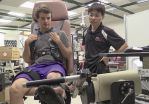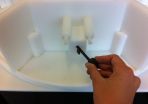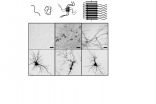(Press-News.org) It's old news that open-source 3D printing has a lot going for it: it's cheap, green and incredibly useful for making everything from lab equipment to chess pieces. Now it's time to add another star to the 3D printing constellation. It may help lift some of the world's most destitute people from poverty while cleaning up a major blight on the earth and its oceans: plastic trash.
At the center of the movement is a new set of standards inspired by fair trade products ranging from diamonds to chocolate.
"We are creating a new class of material called ethical 3D printing filament, like fair trade coffee," said Joshua Pearce of Michigan Technological University. "It's a way to help the poorest of the poor up the economic ladder."
Waste pickers in the developing world barely eke out a living scouring landfills for trash to sell. They usually don't bother with plastic, however, because it has almost no value.
But thanks to an emerging market, waste plastic may soon be a more alluring target; it can serve as a feedstock for 3D printer filament. What makes it especially attractive is the cost of conventional filament made from virgin plastic: about $35 to $50 a kilogram.
Pearce's group has already developed a recyclebot that turns milk jugs and other plastic trash into filament for pennies on the dollar. And next-generation commercial-grade recyclebots are creating opportunities for businesses. But for waste pickers to truly benefit, Pearce says, the recycled filament industry will need to adhere to certain fair labor and environmental practices.
Here's how it would work. Under fair trade standards for ethical 3D printing filament, manufacturers would guarantee that their enterprise meets certain conditions, which Pearce and his colleagues published in the Journal of Sustainable Development. They include the following:
Minimum pricing to assure that workers receive fair wages
A fair-trade premium added to the filament's price that supports development projects
A regular work week of 48 hours and a ban on child labor and forced labor
Environmentally conscious manufacturing practices
Safeguards for workers' health and safety
The right to unionize
A ban on discrimination and sexual and physical harassment
Businesses that make or use ethical filament could charge a premium for their product, though it would still cost less than conventional 3D filament. "Filament prices are so high that places like Protoprint sell their filament at half that price and still give pickers a living wage while doing good for the environment," said Pearce.
Protoprint, a 3D printing firm in Pune, India, is collaborating with techfortrade. The London-based nonprofit harnesses technology to eliminate poverty through economic development. After working with Pearce, techfortrade plans to fully implement his fair trade standards for filament in the Ethical Filament Foundation.
"Joshua's knowledge and his passion, plus his open, collaborative approach, persuaded us that his ethical filament standards would do for 3D printer filament what Fair Trade did for coffee," said William Hoyle, CEO of techfortrade. "We're now close to making this idea a reality; Protoprint is planning to make the first ethical filament offering available in January, and our other ventures in Latin America will follow."
INFORMATION:
The paper on fair trade filament, "Evaluation of Potential Fair Trade Standards for an Ethical 3D Printing Filament," is coauthored by Pearce, Savanna R. Feeley of Michigan State University and Bas Wijnen, a PhD candidate in materials science and engineering at Michigan Tech and published in the Journal of Sustainable Development.
Washington, D.C., October 1, 2014—Use of specific dietary supplements can have a positive effect on health care costs through avoided hospitalizations related to Coronary Heart Disease (CHD), according to a new article published in the Journal of Dietary Supplements(1). The article, "From Science to Finance—A Tool for Deriving Economic Implications from the Results of Dietary Supplement Clinical Studies," published by Christopher Shanahan and Robert de Lorimier, Ph.D., explores a potential cost-benefit analysis tool that, when applied to a high-risk population (U.S. adults ...
Reston, Va. (October 1, 2014) – Researchers at Memorial Sloan Kettering found that PET/CT imaging of patients younger than 40 who were initially diagnosed with stage I–III breast cancer resulted in change of diagnosis. As reported in the October issue of The Journal of Nuclear Medicine, while guidelines recommend FDG-PET/CT imaging only for women with stage III breast cancer, it can also help physicians more accurately diagnose young breast cancer patients initially diagnosed with earlier stages of the disease.
Assessing if and how far breast cancer has spread throughout ...
As the threat of antibiotic resistance grows, scientists are turning to the human body and the trillion or so bacteria that have colonized us — collectively called our microbiota — for new clues to fighting microbial infections. They've logged an early success with the discovery of a new antibiotic candidate from vaginal bacteria, reports Chemical & Engineering News (C&EN), the weekly newsmagazine of the American Chemical Society.
Matt Davenport, a C&EN contributing editor, explains that the human microbiota produces thousands of small molecules. Some have been discovered ...
Here's another reason why it's a good idea to hit the gym: it can improve memory. A new Georgia Institute of Technology study shows that an intense workout of as little as 20 minutes can enhance episodic memory, also known as long-term memory for previous events, by about 10 percent in healthy young adults (see a video demo).
The Georgia Tech research isn't the first to find that exercise can improve memory. But the study, which was just published in the journal Acta Psychologica, took a few new approaches. While many existing studies have demonstrated that months of ...
Materials – Vehicle Lightweighting ...
For about the price of leather seats, automakers can trim approximately 362 pounds off the body and chassis of a midsize passenger vehicle, according to an Oak Ridge National Laboratory study. Researchers analyzed an array of materials – carbon fiber, advanced high-strength steel, aluminum alloys, magnesium alloys – that could replace steel. While the carbon fiber composite option reduced weight by 35 percent at an additional cost of $1,317, a combination of advanced high-strength steel and alloys resulted in a 25 percent weight ...
Pity the poor lithium ion. Drawn relentlessly by its electrical charge, it surges from anode to cathode and back again, shouldering its way through an elaborate molecular obstacle course. This journey is essential to powering everything from cell phones to cordless power tools. Yet, no one really understands what goes on at the atomic scale as lithium ion batteries are used and recharged, over and over again.
Michigan Technological University researcher Reza Shahbazian-Yassar has made it his business to better map the ion's long, strange trip—and perhaps make it smoother ...
People who are unable to button up their jacket or who find it difficult to insert a key in lock suffer from a condition known as apraxia. This means that their motor skills have been impaired – as a result of a stroke, for instance. Scientists in Munich have now examined the parts of the brain that are responsible for planning and executing complex actions. They discovered that there is a specific network in the brain for using tools. Their findings have been published in the Journal of Neuroscience.
Researchers from Technische Universität München (TUM) and the Klinikum ...
Researchers have discovered a new type of brain activity that underlies the timing of voluntary actions, allowing them to forecast when a spontaneous decision will occur more than a second in advance. 'Experiments like this have been used to argue that free will is an illusion, but we think that this interpretation is mistaken,' says Zachary Mainen, a neuroscientist at the Champalimaud Centre for the Unknown, in Lisbon, Portugal, who led the research, published on Sept. 28, 2014, in the journal Nature Neuroscience.
The scientists used recordings of neurons in an area ...
The peptide —a small protein— beta-amyloid is strongly associated with Alzheimer's disease; however, researchers are still looking for unequivocal proof that this peptide is the causal agent of the onset and development of the disease. The main obstacle impeding such confirmation is that beta-amyloid is not harmful when found in isolation but only when it aggregates, that is when it self-assembles to form the so-called amyloid fibrils
"We are not dealing with a single target, beta-amyloid alone, but with multiple ones because each aggregate of peptide, which can go from ...
Current changes in the ocean around Antarctica are disturbingly close to conditions 14,000 years ago that new research shows may have led to the rapid melting of Antarctic ice and an abrupt 3-4 metre rise in global sea level.
The research published in Nature Communications found that in the past, when ocean temperatures around Antarctica became more layered - with a warm layer of water below a cold surface layer - ice sheets and glaciers melted much faster than when the cool and warm layers mixed more easily.
This defined layering of temperatures is exactly what is ...




